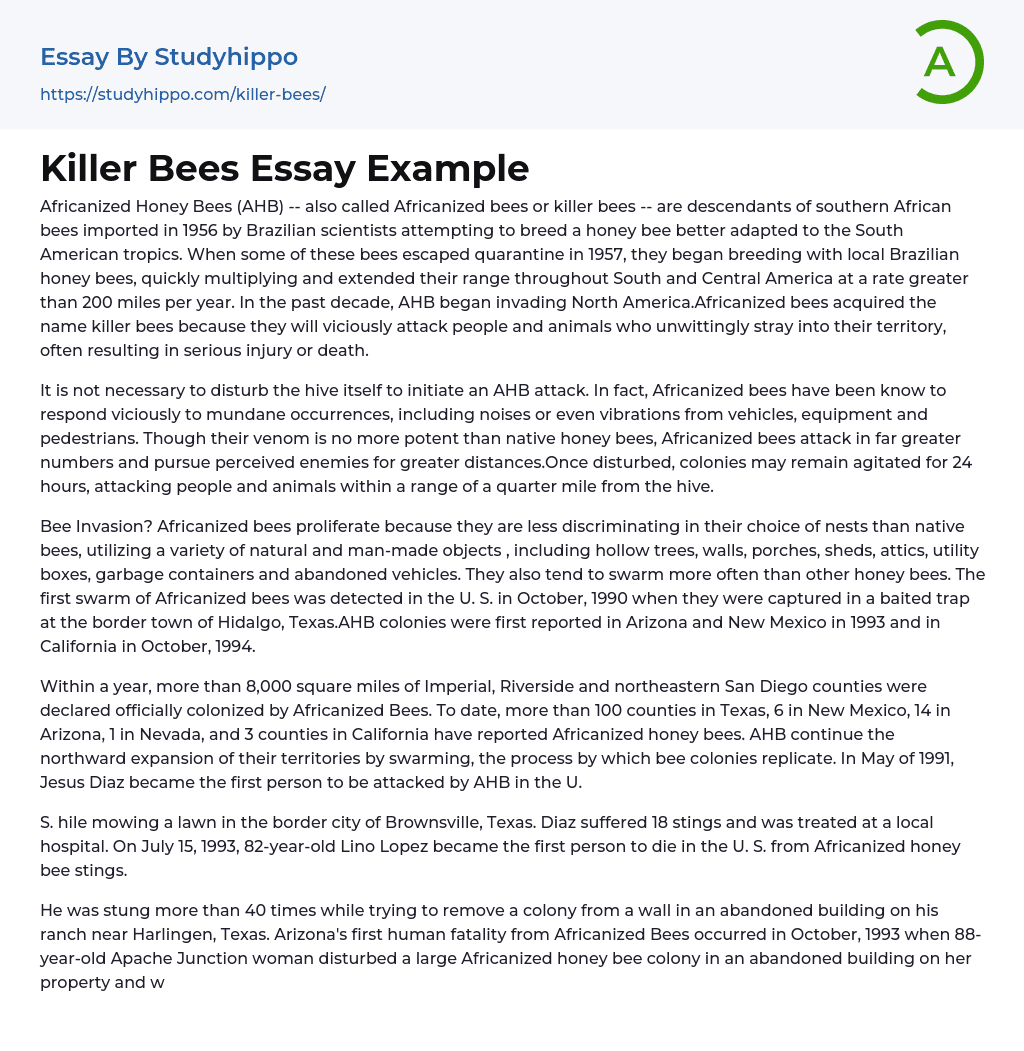
The Africanized Honey Bee, also referred to as the Africanized bee or killer bee, originated from southern African bees and arrived in Brazil in 1956 for the purpose of creating a honey bee more suitable for South American tropics. However, following an escape from quarantine in 1957, these bees interbred with local Brazilian honeybees and rapidly multiplied throughout South and Central America at a pace exceeding 200 miles annually. These bees have now extended their reach into North America. Due to their aggressive behavior towards humans and animals entering their territory, resulting in serious injury or death, they are colloquially known as killer bees.
Disturbing the hive is not a prerequisite for an AHB attack. In fact, Africanized bees can react aggressively to ordinary stimuli like sounds or vibrations emanating from people, vehicles or machinery. Alth
...ough their venom is not more lethal than that of native honeybees, Africanized bees target their perceived foes in larger groups and pursue them for greater distances. Once agitated, colonies remain hostile even up to a day, attacking beings within a radius of 0.25 miles from the hive.
Bee invasion caused by Africanized bees is on the rise due to their less selective nature in choosing nesting sites, preferring a wide range of natural and man-made structures like hollow trees, walls, porches, sheds, attics, utility boxes, garbage containers and abandoned vehicles. Additionally, Africanized bees have a stronger tendency to swarm compared to other honey bees. The discovery of the first swarm of Africanized bees in the United States occurred in October 1990 after they were trapped in Hidalgo, Texas. Since then, AHB colonies have been reported in Arizona and New Mexico in
1993 and California in October 1994.
Over 8,000 square miles of Imperial, Riverside, and northeastern San Diego counties were declared colonized by Africanized Bees within a year. Africanized honey bees have been reported in more than 100 counties in Texas, 6 in New Mexico, 14 in Arizona, 1 in Nevada, and 3 counties in California. The territories of AHB are expanding northward through swarming, the replication of bee colonies. The first reported attack on a person by AHB in the U.S. occurred when Jesus Diaz was attacked in May of 1991.
S. was stung 18 times while mowing a lawn in Brownsville, Texas and received medical treatment. On July 15, 1993, the first known death in the U.S. from Africanized honey bee stings occurred when 82-year-old Lino Lopez passed away.
Trying to remove a colony from an abandoned building on his ranch near Harlingen, Texas, he was stung more than 40 times. In Arizona, the first human fatality from Africanized Bees occurred in October 1993 when an 88-year-old Apache Junction woman disturbed a large Africanized honey bee colony in an abandoned building on her property and was stung numerous times. Although fatalities are alarming, the greatest danger Africanized Bees probably pose in the U.S. is to American beekeeping and agriculture in general. AHBs often mingle and mate with European colonies.
As a result of mating, the presence of African genes and tendencies in hybrid bees increases, which may cause the predominance of their behavior over European bees. This sudden change may lead to the entire colony exhibiting a short-tempered and aggressive demeanor.
- Rabbit essays
- Distribution essays
- Large Animals essays
- Mouse essays
- Poultry essays
- Animal Abuse essays
- Cats Vs Dogs essays
- Cattle essays
- Territory essays
- Travel essays
- Asia essays
- Caribbean essays
- Developing Country essays
- America essays
- City essays
- Africa essays
- Australia essays
- Europe essays
- Georgia essays
- Middle East essays
- New Zealand essays
- South Korea essays
- Thailand essays
- Afghanistan essays
- Dubai essays
- North Korea essays
- Natural Disaster essays
- Earthquake essays
- Fracking essays
- Mountains essays
- Restaurant essays
- Hospitality essays
- Business Travel essays
- Hotels essays
- Tourism essays
- World Tourism Organization essays
- Kids travel essays
- Travel Agency essays
- ecotourism essays
- Air Travel essays
- Sea Travel essays
- Cathedral essays
- Traveling essays
- Fast Food Restaurant essays
- Motel essays
- Cultural Tourism essays
- The real essays
- Airlines essays
- Airports essays
- Boeing essays



